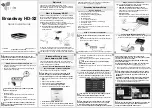
NEO-M9N - Integration manual
The monitor is reporting any currently detected interference over all currently configured signal
bands.
3.14.3 GNSS receiver integrity
3.14.3.1 Secure boot
The NEO-M9N boots only with firmware images that are signed by u-blox. This prevents the
execution of non-genuine firmware images run on the receiver.
3.14.3.2 Secure firmware update
The firmware image itself is encrypted and signed by u-blox. The NEO-M9N verifies the signature
at each start.
3.14.3.3 Receiver configuration lock
The receiver configuration lock feature ensures that no configuration changes are possible once the
feature is enabled. The configuration lock is enabled by setting the configuration item CFG-SEC-
CFG_LOCK to "true".
The configuration lock can be applied to different configuration layers including the RAM, BBR,
and flash memory. At startup, the receiver constructs the configuration database from different
configuration layers and maintains it in the run-time RAM memory. When the configuration lock is
set in the run-time RAM, the receiver configuration cannot be changed on any configuration layer.
For more information on the configuration layers including the order of priority they are
applied in, see the applicable interface description [
].
The configuration lock set on a configuration layer in volatile memory (RAM, BBR) is removed when
the memory is cleared. However, the configuration lock set in non-volatile memory (flash memory)
is permanent apart from one exception: during firmware upload to flash memory, the flash is erased
during the process causing the configuration lock to be cleared. Refer to
for more
information on firmware update.
To test the lock functionality, set it on the RAM configuration layer. After a power cycle, the
information on RAM layer is cleared and the lock is no longer set.
It is recommended to apply the configuration lock on the same layer the configuration is
stored.
3.15 u-blox protocol feature descriptions
3.15.1 Broadcast navigation data
This section describes the data reported via UBX-RXM-SFRBX.
UBX-RXM-SFRBX reports the broadcast navigation data message the receiver has collected from
each tracked signal. When enabled, a separate message is generated each time the receiver decodes
a complete subframe of data from a tracked signal. The data bits are reported as received, including
preambles and error checking bits as appropriate. However, because there is considerable variation
in the data structure of the different GNSS signals, the form of the reported data also varies. This
document uses the term "subframe", but other GNSS data structures might use different terms, for
example, GLONASS uses "strings" and Galileo uses "pages".
UBX-19014286 - R07
3 Receiver functionality
Page 63 of 95
C1-Public















































